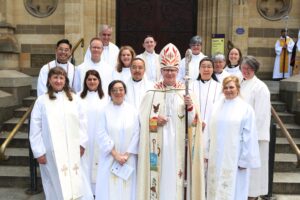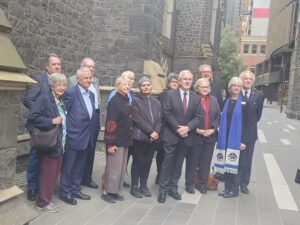
John Forsyth
20 February 2024
Whether you are a lover or a hater, it is impossible to deny the cultural meteor that is Taylor Swift, now in Australia as part of her worldwide Eras Tour. Her concerts at the MCG and Sydney’s Accor Arena sold out in hours as more than four million Australians vied for tickets.
I was among the fortunate, securing tickets through one of seven open devices.
On Saturday I joined 96,000 people, ready to be enchanted by Taylor Swift in person. As we walked from Richmond station the atmosphere was carnival-like. Groups of fans (“Swifties”) dressed as their favourite Swift avatar walked around trading handmade friendship bracelets, inscribed with their favourite Swift songs. Legions of fans who missed out on tickets “Taylor-gated” outside the MCG, finding any way to participate in this mass cultural moment.
Inside the MCG, the performance was remarkable. Taylor Swift took the entire stadium on personal journey through the diverse musical chapters of the past 17 years of her career.
Read more: Mythic and religious resonance haunts Oppenheimer
It was immediately clear that Taylor Swift was not there merely to perform for us, but with us. From the opening song Miss Americana & the Heartbreak Prince to the final song Karma most of the audience sang along, particularly those under 25. Indeed it often seemed the crowd were at least as loud as Taylor, if not more so.
The performance took almost liturgical shape, with a predetermined song list and actions (learnt on TikTok of course) that allowed everyone to be part of the experience. We were treated to 44 songs in 10 acts over three and a half hours with seamless costume changes, a stadium-wide light show, and relentless energy and enthusiasm.
At times Swift performed alone, playing guitar or piano, at others it was a full production with elaborate props, dancers and visuals. Yet somehow, whatever the song, Swift managed to make a personal connection with 96,000 people at once.
It demonstrated one of Swift’s most remarkable qualities: her ability to emotionally connect with our desire for both the transcendent and the immanent through her music.
“While Swift’s genius lies in her ability to connect with our longings, she is ultimately unable to offer any solutions to our longings and pain”
John Forsyth
She is an extraordinarily gifted singer-songwriter, seemingly transcending language and culture – and an untouchable celebrity with a private jet and a Superbowl-winning, football star boyfriend.
Celebrities are our modern-day prophets. They tell us how to live, what to wear even what to eat. Yet at the same time Swift seems incredibly down-to-earth and relatable. She has a song for almost every human experience, from love to grief to revenge to pure joy. She is at the same time both the global megastar and the girl next door. I asked a number of Swifties why they loved Swift so much, and most said, “She is authentic”, “She gets me”, “Her songs are so relatable”, or “She put the words to my emotions”. To be truly seen and understood and by someone transcendent is deeply attractive.
While Swift’s genius lies in her ability to connect with our longings, she is ultimately unable to offer any solutions to our longings and pain. Indeed, in the chorus of her song Anti Hero Swift sings, “It’s me, hi, I’m the problem, it’s me”, cautioning her listeners to not look to their heroes, like Swift, as their saviour. The second verse hints how fame hinders her from having real, meaningful connections: “Sometimes I feel like everyone is a sexy baby/ And I’m the monster on the hill/ Too big to hang out/ Slowly lurching towards your city/ Pierced through the heart but never killed”. The “gift” of being both transcendent and immanent is a burden far too great for a mere mortal.
This of course reminds me of the beauty of the gospel. It declares to the world that in Jesus we have the ultimate transcendence and immanence, as Paul write in Colossians 2:9, “For in Christ all the fullness of the Deity lives in bodily form”.
Read more: RISING had a whiff of sulphur, but Christ’s invitation still resonated
Indeed, Jesus is the only one who is truly able to be both transcendent and immanent.
Although we would agree with Swift that “I’m the problem”, Jesus’ death and resurrection is the definitive love story, the good news for all eras.
Through our faith in him, we all await the far greater event described in Revelation 7:9-10.
“After this I looked, and there before me was a great multitude that no one could count, from every nation, tribe, people and language, standing before the throne and before the Lamb. They were wearing white robes and were holding palm branches in their hands. And they cried out in a loud voice: ‘Salvation belongs to our God, who sits on the throne, and to the Lamb.’”
The Reverend John Forsyth is vicar of St Jude’s Carlton.
For more faith news, follow The Melbourne Anglican on Facebook, Instagram, or subscribe to our weekly emails.







